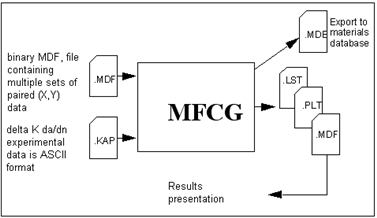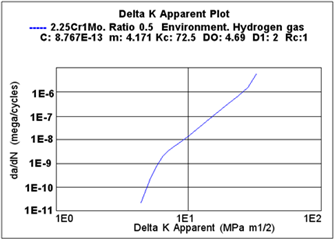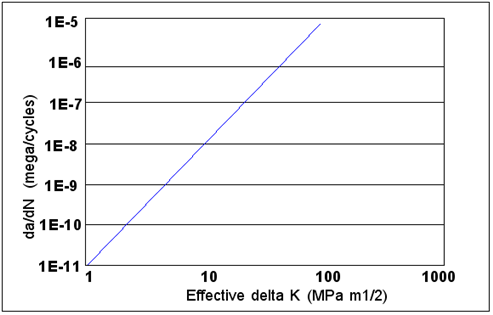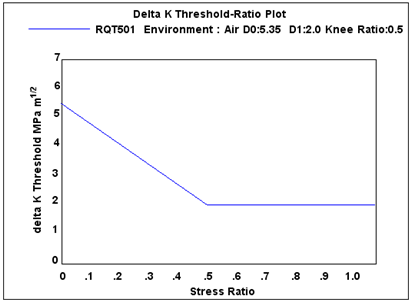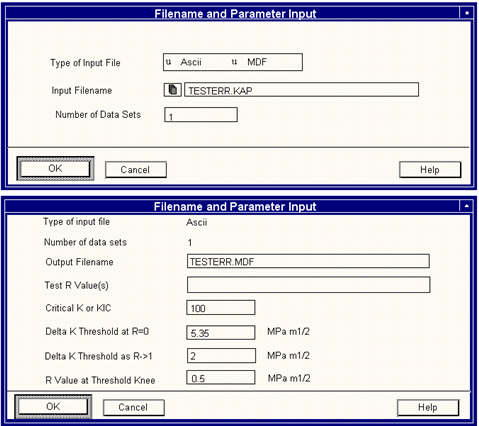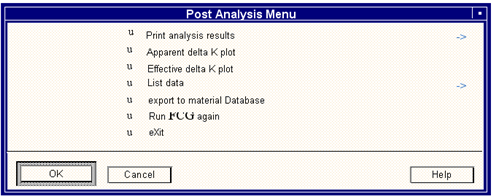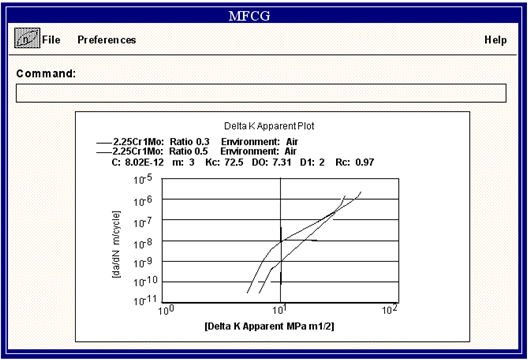XXXXXXXXXXXXXXXXXXXXXXXXXXXXXXXXXXXXXXXXXXXXXXXXXXXXXXXXXXXXXXXXXXXXXXXXXXXXXXXXXXXXXXXXXXXXXXXXXXXXXXXXXXXXXXXXXXXXXXXXXXXXXXXXXXXXXXXXXXXXXXXXXXXXXXXX''"> Crack Growth Data Analysis (MFCG)
The MFCG module calculates the values of the Paris Law coefficient, C, and exponent, m, from actual fatigue crack growth test data obtained under constant amplitude loading conditions. The data is corrected for the influence of crack closure and static fracture modes so that the whole data set may be used to obtain C and m by least squares linear regression.
The input may be from either:
• An ASCII file of paired data points of the form <delta K> <da/dN>, previously prepared using an editor. The default file type is .kap.
• A binary, .mdf, file containing multiple sets of paired (X,Y) data in the form X=<delta K>, Y=<da/dN>. An R value must be entered for each data set used from the file.
The MFCG module calculates the Paris Law coefficient, C, and exponent, m, in the expression:
(7‑3)

The crack growth data, when plotted in log-log format, usually appears as a sigmoidal shape (
Figure 7‑48). The upward swing is due to the increasing contribution of static fracture modes as K
max approaches the fracture toughness, K
IC, leading to rapid unstable fracture. The downward swing is due to the increasing influence of crack closure leading to a threshold ΔK for zero growth rate. It is often difficult to determine C and m from a very limited linear central portion of the data, which may often be really only a single inflection point.
By correcting the “apparent”

values, calculated from measured crack length, load and geometry, to “effective”

values to account for these two influences, it is possible to straighten out the S shape and use the whole data set to determine C and m by least squares regression fitting of a straight line (
Figure 7‑49).
The mathematical formulae for the corrections are derived as follows:
(7‑4)

(7‑5)

(7‑6)

(7‑7)

where Kcl, the crack closure level, is obtained from:
(7‑8)

where R is the stress ratio (K
min/K
max) used in the test and

is the threshold

at that R value.
This leads to the correct version of the Paris Law:
(7‑9)

or
(7‑10)

which is a straight line.
Figure 7‑48 “Apparent” ΔK-da/dN Data
Figure 7‑49 “Effective” ΔK-da/dN Data
To achieve the above calculations MFCG requires the user to enter the following data.
• The critical K or KIC in MPa m1/2
• The test R value
• The delta K threshold at R=0 in MPa m1/2
• The delta K threshold as R->1 in MPa m1/2
• The R value at threshold knee
The critical K or K
IC is the material fracture toughness; the test R value is the stress ratio (minimum/maximum load) at which the laboratory test was carried out; the

threshold at R=0, the

threshold as R tends to unity and the R value at the threshold knee are the 3 parameters which describe the threshold response of a material as a function of stress ratio as per
Figure 7‑50.
Figure 7‑50 Description of ΔKth Response as a Function of Stress Ratio
MFCG is a module which takes an ASCII file of apparent

, da/dN pairs, takes input values of K
IC and

and carries out the corrections and linear regression. A post analysis menu allows presentation of the results and data either numerically or graphically, on screen or written to files. The filtered parameters may be exported to a materials database by MFCG for later use in fatigue crack growth calculations using the PCRACK module. It should be noted that in some circumstances, MFCG can be used to estimate the material values for fracture toughness and threshold from crack growth data by repeated calculations using the module to optimize the best fit to the test data, particularly for a family of datasets from tests conducted at different R values.
MFCG Module Operation
The MFCG module can be operated in one of the following 3 ways:
• From the MSC Fatigue Pre & Post Tools menu system
• In stand-alone mode by typing mfcg at the system prompt.
• By incorporating the MFCG commands in a batch operation.
Once running in interactive mode MFCG will display this screen.
Figure 7‑51 The MFCG File Input and Process Definition Screens
MFCG can process da/dN-

data either as ASCII or binary XY files (.
mfd files). This question asks the user to select which type of input file by choosing one of the toggle options.
Field | Description |
Input File Name | MFCG will prompt the user to enter the name of the data file to analyze. This input file must be either an ASCII file of paired data points in the form of ΔK (, or space) da/dN, previously prepared either by using a standard editor or as a result of data reduction from computer controlled testing (the default extension is .kap) or a two parameter file of ΔK, da/dN (default extension .mdf). |
Output File Name | The next prompt requests the name of an output file to save the results of the MFCG analysis. This will have a .mdf extension by default and the generic name of the input file is offered as a default. Input .kap files are output as .mdf files. The results file is used subsequently for graphical presentation though a printout is also possible from the post analysis menu. If the output file name specified already exists, then the user will be asked to confirm that it is to be overwritten. |
Number of Data Sets (MDF files only) | The input .mdf file may contain several data sets. This question is asking for the number of data sets to be included in analysis. The answer should be a positive number not exceeding the number of data sets defined in the .mdf file. An R value will later need to be specified for each data set included in the analysis. If there are 5 data sets defined in the file and 3 is entered into this field then only the data from the first 3 sets are included in the analysis. |
Test R value | R can be any value between 0 and 1 when the maximum load is positive. R is zero for “zero to tension” loading and -1 is for “fully reversed tension/compression loading”. For fatigue crack growth tests with constant load amplitude and constant R value, R is given by: R=minimum load or stress or K / maximum load or stress or K |
Critical K or K1C | To correct for the influence of static fracture modes (the upward bend of the log-log plot) a value of critical K at fracture, or the fracture toughness value K1C is required for the material under test. |
ΔK Threshold at R=0, and R nearing 1 | The threshold values are used at low da/dN to determine the crack closure influence and to correct the apparent ΔK. The units are MPa m1/2. ΔK threshold is the positive value at which fatigue cracks will not propagate due to the presence of crack closure reducing the effective ΔK to 0. This condition has been experimentally determined at a cut-off rate of 1e-11 m/cycle and measured values vary with R as; ΔK threshold = D0 - (D0-D1) * R/Rc where D0 is the threshold at R=0, D1 is the threshold as R nears 1, and Rc is the R value at the knee point. If the calculated ΔK threshold is less than D1 then D1 is automatically used. |
R value at threshold knee | If the test R value is greater than Rc, MFCG will automatically use the D1 value. |
Post Analysis
When the test data has been defined, clicking OK will process the input file and then display the post analysis screen as in below.
Figure 7‑52 The Postprocessing Menu
Field | Description |
Print Analysis Results | Prints the results as statistically fitted values of m and C, the standard deviation and the correlation coefficient. The page of results are numerical (not graphical plots) and can be seen on screen, or saved as a text file to disk. |
Apparent ΔK Plot | This option plots the original unprocessed input file. It may be plotted as data points only, or a `best fit` S curve can be superimposed on the data points. |
Effective ΔK plot | This option plots the processed input file (the output file). It may be plotted as data points only, or a `best fit` fitted straight line plot can be superimposed on the data points. |
List Data | Lists the apparent ΔK, effective ΔK, and da/dN to either screen or disk file (where they may be imported into most commercial word processors). The number of sets of data values can be indefinitely large depending upon the number of points in the input data file, and there may be many pages of data. |
Export to Material Database | This option allows the materials database to be updated to include the results from this analysis. The choice of databases are from Central, Local, or User. |
Run MFCG Again | Runs MFCG again and returns to screen 1 for another set of experimental data. |
The MFCG Graphical Display System
Figure 7‑53 Graphical Display with Main Menu
The graphical interface is mostly explained elsewhere in this guide and is similar if not identical to other graphical displays in MSC Fatigue. However, some options are tailored to MFCG. Those options are explained below.
Command | Menu option | Meaning |
LI | Line On | Display the statistically fitted regression line to either the apparent or effective ΔK plots. |
NL | Line off | Remove the statistically fitted line from either the apparent or effective ΔK plots. |
Return | | Return to the post-processing menu |
Exit | | Exit to the operating or menu system |
The options pop-up menu contains no unique option; it presents the more commonly used menu options in a very convenient form.
Batch Operation
A list of MFCG’s batch keywords:
Example:
mfcg /inp=test/kic=100/r=0.1/d0=5.35/d1=2/ov=yes/opt=li/opt=hc
/men=a/pltnam=test1/ptit=test 1
This will cause MFCG to read in a file called
test.kap and, using a K
IC of 100 MPa m1/2, D0=5.35, D1=2 and the default threshold parameters (taken from BSI document PD6493, 1988 version) for a test stress ratio of 0.1, write a

effective plot to a plot called
test1.plt and display C, m and statistics to the notebook. By default the .
mdf output file will be
test.mdf (because no /OUT was specified). Examples of graphical output from MFCG are given in
Figure 7‑48 and
Figure 7‑49.
